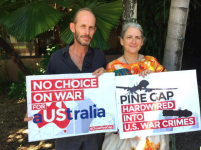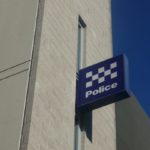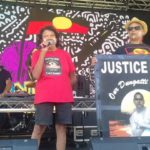Protesting Pine Gap: An Interview with Peace Pilgrim Margaret Pestorius

Pine Gap is the top-secret US-run military base hidden in the Australian outback, just outside of Alice Springs. Officially known as the Joint Defence Facility Pine Gap, the base was presented to the Australian public as a space research centre, when it was established back in 1966.
However, it’s long been known the CIA is behind the actual operations at the base, which initially entailed collecting spy satellite information about the Soviet Union’s missile program.
Pine Gap was staffed by American citizens when it first started operating. But, due to public pressure, half the workforce has been Australian since the 1980s. Although, the US maintains control.
The ABC’s Background Briefing obtained documents in August that reveal some of the intelligence being gathered at facility is used by the US military to locate targets for drone operations.
US drone strikes have been blamed for hundreds of civilian deaths in countries like Iraq and Syria.
According to Human Rights Law Centre advocacy director Emily Howie, this could leave Australians open to prosecution for war crimes. She told the ABC “the legal problem that’s created by drone strikes is that there may very well be violations of the laws of armed conflict.”
And many argue that Australia’s involvement at the base could pose a threat to national security.
Unlawful entry
In September last year, around 200 activists converged on the installation to conduct the week-long Close Pine Gap protest, marking the fiftieth anniversary of the base. The demonstrators sought to break the silence on the role of the facility in war, surveillance and nuclear targeting.
A group of five Christian protesters broke through the boundary of the military base and entered the grounds in the early hours of September 29. The activists, who had the aim of stopping drone strikes, were followed in by Australian federal police and apprehended.
The initial charges laid against them were thrown out of court, as police had failed to gain approval from the federal attorney general prior to starting the prosecution, which is a requirement under Commonwealth law.
Harsh penalties
In December last year, Australian attorney general George Brandis authorised the prosecution under the Defence (Special Undertakings) Act 1952. The Act provides protections for areas reserved for “the defence of Australia and the defence of another country.”
Section 8A of the Act classes the Joint Defence Facility Pine Gap as a prohibited area. The group were charged with unlawfully entering a prohibited area, contrary to section 9 of the Act. The maximum penalty for this offence is 7 years imprisonment.
Long-time activist Margaret Pestorius and the four other protesters were found guilty by the Alice Springs Supreme Court in late November. At the sentencing hearing last week, the court imposed hefty fines, but the protesters walked free.
Sydney Criminal Lawyers® spoke with Peace Pilgrim Margaret Pestorius about the operations at the secretive military base, the proceedings in court, and what she believes the group of activists achieved via their peaceful protest and subsequent trial.
Firstly, Margaret, the secretive military base Pine Gap has been operating in the Australian outback for decades now. In your understanding, what was it originally established for?
It was established as part of the Cold War to trace nuclear activity. It was supposed to trace the movements of ballistic missiles. So, they had these sensors to see if anybody had fired any nuclear weapons. They still have these things.
They called it a space research base. But, it doesn’t appear to have ever been one. It did have this aspect of tracing from space, or through signals, intense heat from the firing of a nuclear weapon.
But, over subsequent decades, the operations carried out there have broadened. What are some of the more recent functions of the installation?
Now, it also has a collector function. This came out in the Edward Snowden papers. It collects all digital signals. And it also has antennas which collect mobile phone signals.
So, it’s mainly a signalling collection place. It does two things. It collects from satellites coming down. And it also has ground based antennas that collect signals going around and around.
It’s my understanding these signals are used in drones strikes.
Well, airstrikes. One of the clearest connections now is with the CIA assassination program. The CIA have always had various types of assassination programs.
They had to shut down their gaols at Guantanamo Bay. They had these gaols that were very problematic, as they discovered there was a whole lot of war crimes being carried out in them.
Over the next few years, they shifted to using drones for assassinations. They use Pine Gap to identify patterns of signals that might be from someone they should assassinate. They use those patterns of signals to decide on assassination targets.
And they then use hellfire missiles attached to drones to assassinate people. They don’t necessarily know who those people are. They’re just identified by patterns of signals, and by the way their mobile phones get used.
Often, they miss the people. They’re not accurate. And they end up taking out groups of people who are not necessarily connected to the original target.
Just how important is Pine Gap for US military operations?
According to Richard Tanter, it’s very important. They require it to run these assassination programs. Without the signalling given by Pine Gap, they couldn’t run the programs in the same way that they do.
What would you say the implications are for Australia allowing the US to perform these military operations within its borders?
The government bows to the US, as they will have their government undermined if they go against US foreign policy. So, it hardwires us into their system militarily. But it also, hardwires the community in economically. And it hardwires our foreign policy into US foreign policy.
It becomes almost impossible to extricate, or have an independent version of, any of those three things: economics, the military or foreign policy.
So, you carried out a peaceful protest at the facility in September last year. What instigated it? And what did it entail?
We were invited by the organisers of the rally to be part of the broader protest. And we made that contribution, because that’s something we have been doing in the years leading up to 2016.
As a group we had been gathering at Talisman Sabre, which is the biggest joint US-Australian military exercise held every two years at Rockhampton.
We’ve been undertaking these incursion pilgrimages at Talisman Sabre, where we would go into the bush, and encounter the military in various sorts of ways. Just like ordinary civilians encounter the military when they invade their countries, we’d encounter the military on Darumbal country in Rockhampton.
So, we developed the idea of the Peace Pilgrims. Different identity groups do these sorts of pilgrimages, usually in groups of three or four. There’s a group of Quaker grannies that did a pilgrimage. There’s a group of Christian ministers from Victoria who did one. And I’ve done two or three over the years.
So, we took that idea to Pine Gap. Our idea was to go and shine a light in the dead of night. In the same sort of way, we did at Rockhampton at Shoalwater Bay.
We thought that if we did that we’d have a chance of interrupting the drone strikes, which we knew were increasing significantly over that period. They were going from three to four to five a day, just in the time that we were there.
So, you entered the facility?
There was six of us, and we went in two sets. So, five of us went in together. And then one of us went in on another night. We entered and prayed. And we played a musical lament.
We wanted to see the facility, consider the harm that was done, and break the denial that goes on in Australia about the way we’re implicated directly in US military operations.
And the federal police eventually arrested you.
It turned out the police had been following us. But, it took them quite a while to arrive. In different circumstances we may have got further, or got to play our lament longer.
But, we did OK. We got as close as we could. And we got to play our lament while overlooking the base and noticing what was going on there.
You stood trial at the Alice Springs Supreme Court. Your case began in mid-November. What were you actually charged with? And what do the laws you were charged under provide?
We were charged under section 9 of entering a prohibited area. It’s like a trespass law, but it’s under the Special Undertakings Act, which had been amended in 2010.
It’s just a trespass law. But a complex one, with these outrageous sentences. So, we were facing 7 years in prison for the highest level, or very high fines. We were concerned that we would be going to gaol.
We ran the case ourselves. We didn’t have much legal support. It’s very hard to get pro bono legal support in Alice Springs. Because you have to go there, and people knew it would be very hard to get defences up.
We managed to get our defences in front of the jury. But, they were withdrawn at the point of dismissal.
So, the Special Undertakings Act provides trespasser laws for defence-related areas?
It’s special defence legislation that’s designed to stop people having access to these highly secretive and specialist military operations. It’s a fancy trespass law.
There’s certain things attached to it. You can’t have a camera in there. You can’t take any photos. And one of us was charged with having a camera and taking photos.
The trial finished up last week. What was the outcome?
We got very stiff fines in sentencing. We were found guilty, because they didn’t put our defences to the jury in the end. We were allowed to lead all the evidence in front of the jury, but then, the judge ruled that the defence should not be put to the jury.
The defences that we ran were 10.3 and 10.4 of the Australian Criminal Code, which were that we acted because of an extraordinary emergency, and because we were in defence of others.
We argued that there were three to five drone strikes a day, so if we could stop the operations, even for a short time, we would perhaps be stopping a drone strike that would kill up to 14 or 15 people.
And in fact that week, there was a drone strike that killed 15 people – a single drone strike aimed at one person. It’s possible that we could have interrupted that drone strike. We don’t know.
But, that had been our argument. We were allowed to put the argument. But, he didn’t put it to the jury. So, the jury couldn’t make a decision based on that defence.
It’s very hard to get these defences up in Australia, these so-called necessity defences: that you have to act because it’s necessary to do so.
And there are no defences to say that we acted because it was the right thing to do, or because the Nuremberg principle says we must act to stop war crimes. It truly is our belief that war crimes were occurring in that place.
What would you say the overall effect of your protest and the trial has been?
Certainly, we as activists have used to the trial to raise the profile of Pine Gap. When you are repressed like that, and facing time in prison for a simple trespass, and trying to raise a conversation about what’s going on in this country, it needs to be pushed back against.
So, I think we did a good job in using the court case and their use of this legislation. They didn’t have to use this legislation, or run it in the Supreme Court, and charge us in this particular way. They chose to do that.
We used the opportunity they created to shed more light, and we managed to do that very well. In fact, there was a lot higher profile around our court case, then there was around the original arrest, or the two hundred people protesting that week at the end of September 2016.
We also got to show that you can use the repression of the state to backfire against it. If you are going to use this sort of repressive legislation against people who simply dissent, then you’re going to have to face that we will use it to make as much publicity as possible.
And lastly, what will be the next move for the Peace Pilgrims? Do you plan on drawing attention to Pine Gap again, or moving onto something else?
We went there because of the fiftieth anniversary. That’s what led us there. In Australia, we need to look at political targets where we can get some traction. And it’s very hard to go after the US-Australian alliance directly, because there’s such bipartisan support from the Labor party.
For a time, it’s important to start to draw the links between the growth in Australian militarism, its relationship to the US, and particularly, its relationship to US corporations that use Australia as a market.
Australia is basically being used as a franchise business. A bit like Amway, or a coffee business. Where we have to buy the most expensive equipment from our franchise bosses, in order to run the franchise for the US.
The idea of the client state, where we are just really an arm, or an extension, of the US. We do the US’s work. But, not necessarily in Australia. We go overseas, and we do the US’s dirty work.
But, what we do here in Australia is buy the US equipment at an enormous cost and for no benefit at all for Australia. In fact, for the detriment of Australia.
Because the cost of that equipment is a premium price and it comes at the expense of our own services: welfare, education and health services.







